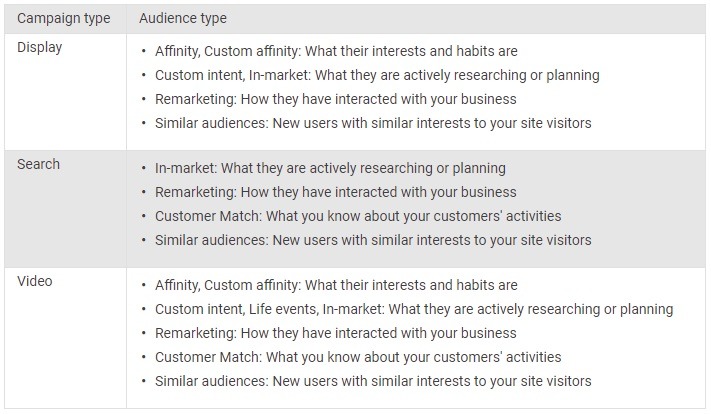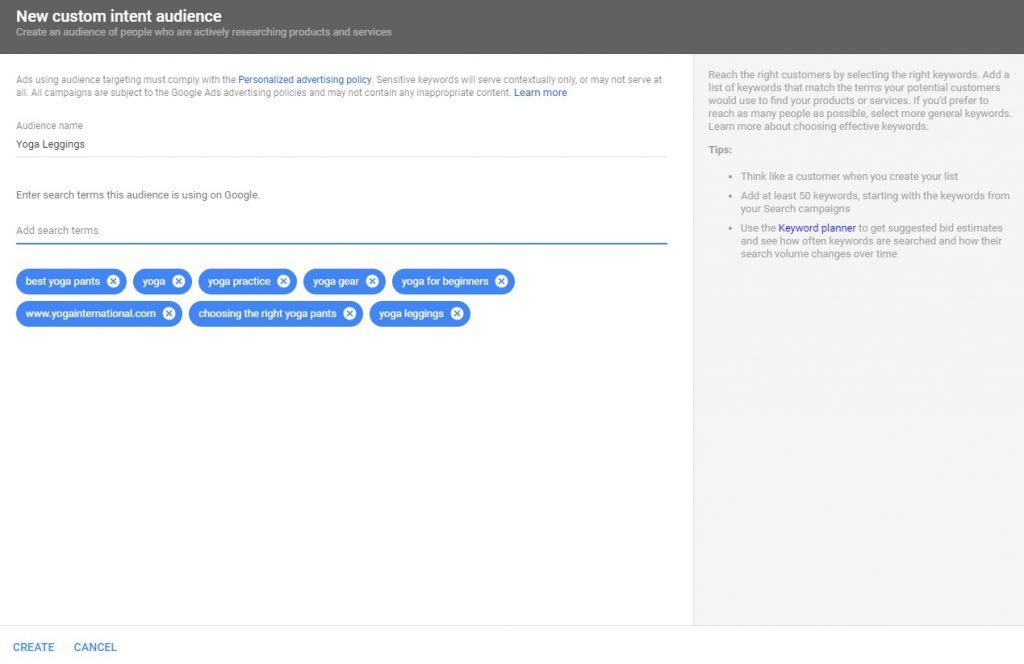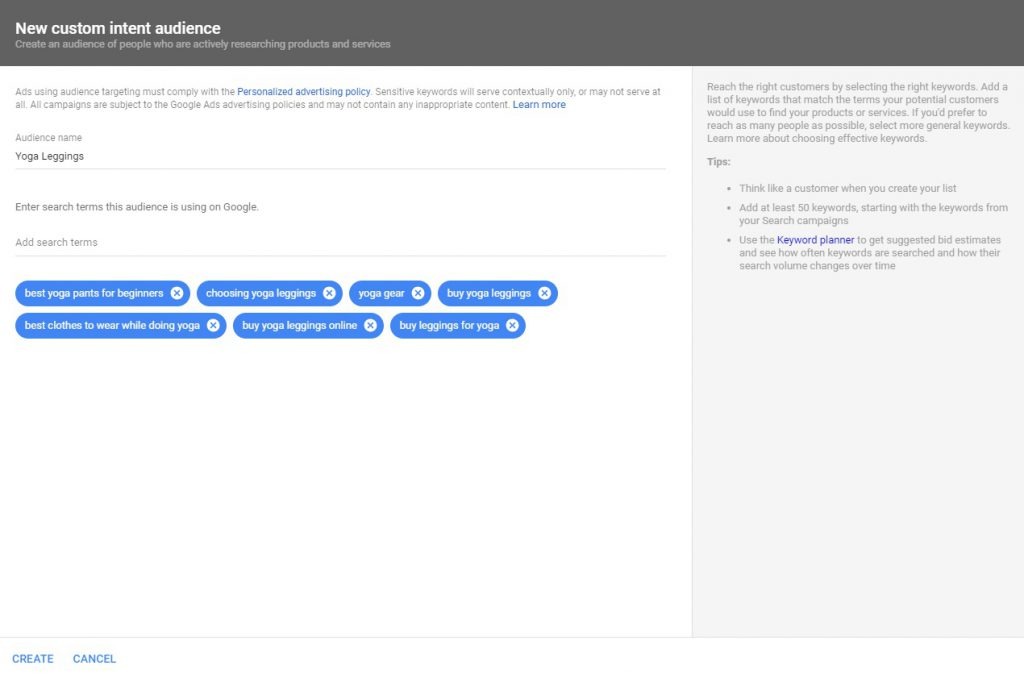Custom Intent Audiences aren’t new, but using them for better YouTube targeting is a new concept for many eCommerce marketers since they launched last year. Google then launched TrueView for Action ads, specifically designed to work with custom intent audiences and meet response objectives; and the stats speak for themselves. In a Google Nextiva case study, the company’s site traffic jumped by 20% using TrueView Campaigns and their video shares went up 650%.
In short, custom intent audiences allow you to reach target audiences who are actively looking for products or services you’re selling. And when used with YouTube, you have access to audiences watching 438 million hours worth of product review videos and over 1.5 billion active users.
The most significant advantage of Google enabling advertisers to use search intent with YouTube ad targeting is that marketers are able to set up Google Ads video campaigns with related keywords, allowing you to reach potential shoppers watching YouTube content. Let’s use a simple example: Let’s say you’re a successful online legging store; you could reach likely shoppers on YouTube who recently Googled ‘yoga wear’ and deliver campaign content highly relevant to those searchers.
If you’re already familiar with GDN (Google Display Network) targeting, then you’ll find YouTube custom intent audience targeting to be very similar.
Beginner Tip:
If you’re a newbie YouTube marketer you may be asking, What is the difference between in-market and custom intent audiences? Simply put, in-market targets those potential shoppers at the research stage of the sales funnel while custom audiences give you more segmentation options to reach active searchers for your products. Here’s a breakdown of the different audience types to use for targeting in your campaigns:
So how do you use custom intent audiences to improve YouTube targeting? The first thing you need to ensure is that you have the right ad group structure. Here is how you can structure your Ad Groups for custom intent audiences and then three ways to use this audience type to improve your YouTube targeting.
Setting Up Your Custom Intent Audience YouTube Ad Groups Correctly
The first step in using YouTube custom intent audiences to your advantage is ensuring that your campaigns and ad groups are structured for max performance. As we know, the right ad group set ensures proper campaign segmentation for good results. However, intent audience group segmenting may be slightly different from what you’re used to and will differ depending on your account and objectives.
To get the most out of your YouTube targeting, you want to structure your ad groups in such a way that segments are based on converting search terms from your Google Ads campaigns as well as on the users’ intent. Let’s use the online legging store example again, showing you how to structure your campaign into three groups.
Custom intent ad group 1
- Video: Yoga product video
- Terms: Yoga terms
Custom intent ad group 2
- Video: Yoga product video
- Terms: Yoga gear terms
- The theory here is that although a potential shopper’s search query intent will differ from search terms such as ‘online yoga goods store’ and ‘yoga leggings for sale,’ they would be interested in what you’re selling.
Custom intent ad group 3
- Video: Yoga product video
- Terms: Converting terms from Google Ads campaigns
- The idea here is to show your campaign video content to potential shoppers actively searching, using search terms that have converted well in the past.
Basically, by breaking your segments down for custom intent audience campaigns you create, you could then add extensions, adjust bids and optimize campaigns at an ad group level.
Pro Tip: To speed up your custom intent audience campaigns after creation, consider including your overall best-performing keywords as well as your closest competitors. As YouTube generally leads to less expensive reach on high average CPC terms, this can be particularly useful.
Attracting New Shoppers With YouTube Custom Intent Audiences
Custom intent audiences on YouTube are a great way to fine-tune your targeting to reach brand-new potential shoppers – shoppers who are actively looking for your kinds of products and you can push up your sales funnel with remarketing campaigns later on.
What you want to do is tap into some of the most basic research terms potential shoppers are using as well as the websites they’re already looking at, and then replicate them when creating your custom intent audiences for YouTube.
Again using the leggings store example, let’s assume you want to reach new shoppers who are yoga beginners. You could create a video aimed at new yoga practitioners, highlighting why your leggings are a great buy. You could then use popular research terms for the beginners when creating your audiences, as well as the websites they are likely to have visited.
Reaching Potential Shoppers Actively Looking for Very Specific Products With YouTube Custom Intent Audiences
Another way custom intent audiences improve YouTube ad targeting is the ability to target specific product segments. This is particularly helpful for eCommerce businesses, as intent audiences enable precise targeting that reaches shoppers actively in the process of searching for the products you’re selling.
Unlike the above example, you also want to be very specific with your keywords aimed at active shoppers. By matching your product videos, how-to-guides and other video content, you are able to get these videos in front of very potential shoppers active in the niche you’re marketing to.
Wrap Up
Like with all Google Ads, before you throw all your money into the ring, you want to test audiences on smaller budgets until you find the best-performing custom intent audience setup for your brand. If you’re new to YouTube advertising, be sure to check out our complete guide to YouTube ads. For those of you wanting a more automated approach, better ROIs and less hassle, our traffic experts are waiting to answer any Traffic Booster questions you may have.

Nicole is a content writer with over sixteen years experience and flair for storytelling. She runs on a healthy dose of caffeine and enthusiasm. When she's not researching the next content trend or creating business content strategies, she's an avid beachgoer, coffee shop junkie and hangs out on LinkedIn.
Recommended articles
 Facebook Ads for eCommerce: 16 Strategies, Examples & Tips
Facebook Ads for eCommerce: 16 Strategies, Examples & Tips
 How to Build a Winning eCommerce Ads Strategy
How to Build a Winning eCommerce Ads Strategy
 Google Ads for eCommerce: Everything You Need to Know
Google Ads for eCommerce: Everything You Need to Know
 10X Your Traffic with PPC Management Software
10X Your Traffic with PPC Management Software
Comments
Powered by Facebook Comments






